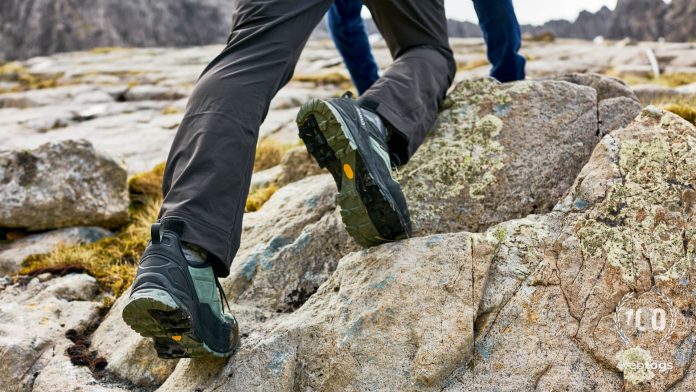Hiking shoes are excellent for walking due to their sturdy construction and ankle support. Hiking shoes are designed with durability and ankle support in mind, making them an ideal choice for walking.
With their sturdy construction, these shoes offer protection and stability, allowing you to navigate various terrains comfortably. Whether you are strolling in the park or exploring challenging trails, the grip and traction provided by hiking shoes ensure a secure footing.
Additionally, their cushioning and shock absorption capabilities minimize the impact on your feet and joints, reducing the risk of injuries. Whether you’re a seasoned hiker or a casual walker, investing in a pair of hiking shoes will enhance your walking experience and provide the necessary support and comfort for extended periods of walking.
Are hiking shoes good for walking: Hiking Shoes Vs. Walking Shoes
Discover the key differences between hiking shoes and walking shoes, including their unique benefits and features. Find out if hiking shoes are suitable for walking and how they can enhance your overall walking experience.

With features like waterproofing and advanced traction, hiking shoes are designed to keep you comfortable and safe even in challenging conditions. Whether you’re a seasoned hiker or simply enjoy walking outdoors, investing in a good pair of hiking shoes can greatly enhance your walking experience.
Many people wonder whether hiking shoes could also double as walking shoes. While there may be some similarities between the two, it’s important to understand the key differences that set them apart. In this section, we’ll discuss the key features of hiking shoes and walking shoes to help you make an informed decision.
Key Features Of Hiking Shoes:
- Durability: Hiking shoes are designed to withstand rough terrain and harsh conditions. They are typically made from sturdy materials like leather or synthetic fabrics to provide maximum durability and protection. Check more in Adidas Terrex Swift R2 Review, Salomon X Ultra 4 Review.
- Traction: Hiking shoes come with robust outsoles that offer excellent grip on uneven and slippery surfaces. The deep lugs and patterns on the sole are specifically designed to provide enhanced traction, allowing you to navigate through various terrains with ease.
- Ankle Support: Hiking shoes often feature high-cut designs that provide stability and support to your ankles. This feature is particularly important when traversing rocky or unstable trails, as it helps to prevent injuries and ankle sprains.
- Waterproofing: Depending on the type and brand, hiking shoes may also come with waterproof or water-resistant properties. These features help to keep your feet dry and protected from wet conditions, such as rain or walking through streams.

- Protection: Hiking shoes often incorporate protective elements like toe caps and reinforced heel counters. These features shield your feet from impacts, rocks, and debris encountered on the trails.
Key Features Of Walking Shoes:
- Cushioning: Walking shoes prioritize comfort and cushioning to provide a pleasant walking experience. They usually have generous amounts of padding, particularly in the midsole and heel areas, offering impact absorption and reducing pressure on the feet.
- Flexibility: Walking shoes are designed to allow natural foot movement and flexibility. The materials used are often more lightweight and flexible compared to hiking shoes, enabling a smoother and more comfortable stride during walks.
- Breathability: Given that walking shoes are primarily intended for urban or casual use, breathability is a crucial feature. These shoes often incorporate breathable mesh or perforated materials to ensure proper ventilation and prevent excessive sweating.
- Versatility: Unlike hiking shoes, walking shoes are typically suitable for various terrains, including pavements, parks, and indoor environments. They offer a balance between performance and style, allowing you to transition seamlessly between different activities. Good examples are Skechers Go Walk Walking Shoes, Best Ryka Walking Shoes.
- Arch Support: Walking shoes often provide adequate arch support to accommodate different foot types. This helps to maintain proper alignment and prevent discomfort or pain during long walks.
Understanding the differences between hiking shoes and walking shoes can help you choose the right footwear for your specific needs. Whether you’re planning a hike through the mountains or enjoying a leisurely stroll in the city, having the appropriate footwear ensures comfort, support, and protection for your feet.
Benefits Of Using Hiking Shoes For Walking
Hiking shoes offer numerous benefits for walking, providing excellent support, comfort, and traction on various terrains. They are designed to protect your feet, reduce fatigue, and prevent injuries, making them an ideal choice for anyone who enjoys walking adventures.
Comfort And Support While Walking:
- Hiking shoes are designed to offer exceptional comfort and support during long walks. The cushioned insole and padded collar provide a soft and snug fit, reducing foot fatigue and discomfort.
- These shoes are equipped with a supportive midsole, which provides stability and shock absorption, preventing potential injuries and reducing strain on the feet, ankles, and knees.
- With their anatomical design, hiking shoes conform to the natural shape of your feet, promoting a proper walking gait and ensuring maximum comfort throughout your journey.
Durability And Traction On Various Terrains:
- Hiking shoes are built to withstand rugged terrains and challenging conditions. They are made from sturdy materials such as leather, synthetic fabrics, and rubber, ensuring durability and long-lasting performance. Still you may check, When to Replace Climbing Shoes for betterment time to time.
- The robust outsoles of hiking shoes feature deep lugs or treads, providing superior traction on different surfaces, including gravel, slippery rocks, muddy trails, or uneven terrain. This increased grip helps maintain stability and prevents accidental slips or falls.
Protection Against External Elements:
- Hiking shoes offer protection against external elements, such as sharp rocks, thorns, or branches. The reinforced toe caps safeguard your toes from accidental impacts, providing a buffer between your feet and any hazards on the trail.
- Most hiking shoes are also designed to be water-resistant or waterproof, keeping your feet dry and comfortable in wet conditions. This feature is especially useful when walking through puddles, streams, or rain-soaked trails.
Using hiking shoes for walking provides a range of benefits, including unrivaled comfort and support, durability and traction on different terrains, and protection against external elements. These features make hiking shoes an excellent choice for those seeking a comfortable and enjoyable walking experience, even in challenging environments.
Factors To Consider: Hiking Shoes For Walking
When choosing hiking shoes for walking, it’s important to consider factors such as comfort, durability, grip, and support. These factors contribute to the overall performance and effectiveness of hiking shoes for walking, making them a good choice for outdoor enthusiasts.

Hiking shoes not only provide comfort and support on rugged trails but can also be a great option for everyday walking activities. When selecting hiking shoes for walking, there are a few key factors to consider to ensure you find the perfect fit.
From fit and sizing considerations to material and construction choices, and even weight and breathability, understanding these factors will help you make an informed decision.
Fit And Sizing Considerations:
When it comes to hiking shoes for walking, getting the right fit is crucial for optimum comfort and support. Here are some important fit and sizing considerations to keep in mind:
- Size: Choose hiking shoes that offer a snug fit, neither too tight nor too loose. Consider trying on shoes in the afternoon when your feet tend to be slightly larger.
- Toe Box: Look for a spacious toe box that allows your toes to move freely. This helps prevent blisters and discomfort.
- Arch Support: Determine your foot arch type and select hiking shoes that provide appropriate arch support—whether you have high arches, low arches, or neutral arches.
- Ankle Support: Depending on your preference, you can opt for hiking shoes with low ankle support for more flexibility or ones with high ankle support for added stability.
Material And Construction:
The quality of materials used in the construction of hiking shoes is important for durability and performance. Consider the following aspects:
- Upper Material: Look for hiking shoes made from breathable materials, such as mesh or synthetic fabrics. These materials allow for proper airflow, reducing the chance of sweaty and uncomfortable feet.
- Outsole: A durable and grippy outsole is a must for hiking shoes. Check for deep lugs and a good tread pattern for enhanced traction on various terrains.
- Waterproofing: If you plan to walk in wet conditions, consider waterproof hiking shoes to keep your feet dry and protected from the elements.
- Reinforcements: Reinforcements, such as toe caps and heel counters, provide additional protection against rocks and uneven surfaces.
Weight And Breathability:
The weight and breathability of hiking shoes can greatly impact your walking experience. Here are some points to take into account:
- Weight: Lightweight hiking shoes make walking for extended periods easier and less tiring. Choose shoes that strike a balance between durability and weight.
- Breathability: Proper ventilation is essential to keep your feet cool and comfortable during walks. Look for shoes with breathable materials and features like moisture-wicking liners.
By considering these important factors – fit and sizing, material and construction, and weight and breathability – you can find hiking shoes that are not only good for walking but also meet your specific needs. With the right pair of hiking shoes, you can enjoy comfortable and enjoyable walks, no matter the distance or terrain.
Tips For Using Hiking Shoes For Walking
Hiking shoes are excellent for walking, providing stability, traction, and support. With proper fit and comfort, they can be a great choice for long walks or outdoor adventures. Remember to break them in before embarking on any strenuous hike.
Hiking shoes are not just for hiking. They can also be a great option for everyday walking. In fact, many people find that hiking shoes offer more comfort, support, and durability than regular walking shoes. If you’re considering using hiking shoes for walking, here are some tips to help you make the most of your footwear:
Breaking In Hiking Shoes For Maximum Comfort
- Start by wearing your hiking shoes for short walks around your neighborhood or on easy trails.
- Gradually increase the duration and intensity of your walks to allow your feet and shoes to adjust.
- Pay attention to any areas of discomfort or pressure points, and consider using moleskin or other protective measures to prevent blisters.
- Make sure to properly lace up your shoes to ensure a secure and comfortable fit.
- Take the time to break in your hiking shoes before embarking on long hikes or challenging terrains.
Choosing The Right Socks For Walking In Hiking Shoes
- Opt for moisture-wicking socks that help keep your feet dry and reduce the risk of blisters.
- Consider wearing cushioned socks for extra comfort and support, particularly if you have sensitive feet or plan on walking for extended periods.
- Avoid cotton socks, as they tend to retain moisture and can lead to discomfort and blisters.
- Experiment with different sock thicknesses and materials to find what works best for you and your hiking shoes.
Maintaining And Cleaning Hiking Shoes For Longevity
- Clean your hiking shoes after each use by removing dirt and debris.
- Avoid using harsh chemicals or abrasive brushes, as these can damage the material of your shoes.
- Allow your shoes to air dry naturally, away from direct heat sources, to preserve their shape and integrity.
- Regularly inspect your shoes for any signs of wear and tear, and address any issues promptly.
- Apply a waterproofing treatment to keep your hiking shoes protected from moisture.
By following these tips, you can make the most of your hiking shoes for walking. Remember to prioritize comfort, support, and durability when selecting your footwear. Whether you’re strolling through the park or tackling challenging trails, hiking shoes can be a reliable and versatile option for your walking adventures.
Potential Drawbacks Of Using Hiking Shoes For Walking
Hiking shoes may not always be the best choice for walking due to their heavy and rigid nature, which can cause discomfort and fatigue. Additionally, the durable, thick soles of hiking shoes might be overkill for walking on smoother surfaces.
Hiking shoes are undoubtedly a reliable choice for outdoor enthusiasts who enjoy exploring rugged terrains and uneven trails. However, when it comes to walking on smoother surfaces for prolonged periods, there are a few potential drawbacks to consider. Let’s delve into these limitations before deciding if hiking shoes are the right choice for your walking needs.
Heavier Weight Compared To Walking Shoes:
- Hiking shoes are specifically designed for stability and durability in demanding environments, such as rocky trails or steep inclines. Consequently, they tend to be heavier than traditional walking shoes, which are optimized for lighter and more fluid movement. The extra weight can lead to increased fatigue during extended walks.
Less Flexibility For Speed Walking:
- While hiking shoes excel in providing support and protection, they may have limited flexibility compared to specialized walking shoes designed for speed and agility. Walking shoes prioritize freedom of movement and speed, making them a more suitable choice for those who prefer brisk walking or power walking.
Limited Style Options:
- Unlike walking shoes, hiking shoes often prioritize function over fashion. Though hiking shoes come in various styles and designs, the options may be more limited compared to the vast range of designs available in walking shoes. If style is an important consideration for your walking footwear, you might find hiking shoes to be lacking in the style department.
It’s important to carefully evaluate your walking needs and preferences when deciding between hiking shoes and walking shoes. While hiking shoes offer sturdy support and protection, they may not be the most optimal choice for extended walks on smooth surfaces due to their heavier weight, less flexibility for speed walking, and limited style options.
Consider trying both types of footwear to determine which one provides the best support, comfort, and overall experience during your walks.
FAQ: Are Hiking Shoes Good For Walking
Are Hiking Shoes Good For Walking Long Distances?
Yes, hiking shoes are designed with sturdy soles, supportive cushioning, and ankle protection, making them ideal for walking long distances. They provide stability and comfort to help reduce fatigue and prevent injuries during extended walks.
Can I Wear Hiking Shoes For Everyday Walking?
Absolutely! Hiking shoes are not just for hiking trails. Their durable construction, cushioning, and grip make them perfect for everyday walking. Whether you’re exploring the city, running errands, or taking leisurely walks, hiking shoes provide the comfort and support you need.
Are Hiking Shoes Suitable For Walking On Pavement?
Hiking shoes are versatile enough to handle various terrains, including pavement. Their rugged outsoles offer excellent traction, which ensures stability and reduces the risk of slipping on surfaces like pavement. So, feel free to wear your hiking shoes when walking on roads or sidewalks.
Last Talk: Are Hiking Shoes Good For Walking
To sum up, hiking shoes can be a great option for walking. They offer excellent support and stability, allowing you to navigate various terrains with ease. The durable construction ensures they withstand the rigors of long walks, providing long-lasting comfort and protection for your feet.
So, next time you head out for a walk, consider slipping into a pair of hiking shoes and enjoy the benefits they bring to your feet and overall walking performance.


